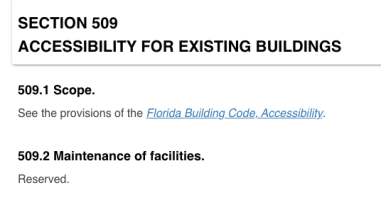jar546
CBO
Florida takes the ANSI A117.7 and makes it their own by removing Chapter 11 from the IBC and placing scoping in the beginning of their edited version of the ANSI, calling it the FBC Accessibility. Most of it is verbatim with some changes. Here is 101.2 of the FBC Accessibility with some verbiage you may not see in the ANSI A117.1.
This code applies to alterations to existing facilities that are subject to the barrier removal requirement under Title III of the ADA to the extent required by regulations issued by the Department of Justice incorporated in 202.6.1 and to alterations undertaken by Title II entities to provide program access.
This document does not address existing facilities unless altered at the discretion of a covered entity. The Department of Justice has authority over existing facilities that are subject to the requirement for removal of barriers under Title III of the ADA. Any determination that this document applies to existing facilities subject to the barrier removal requirement is solely within the discretion of the Department of Justice and is effective only to the extent required by regulations issued by the Department of Justice.
101.2 Effect of Removal of Barriers in Existing Facilities
Removal of architectural barriers, pursuant to 28 C.F.R. s. 36.304, from buildings, structures or facilities shall comply with this code’s requirements for alterations unless compliance would render the removal not readily achievable. In no instance shall the removal of an architectural barrier create a significant risk to the health or safety of an individual with a disability or others.This code applies to alterations to existing facilities that are subject to the barrier removal requirement under Title III of the ADA to the extent required by regulations issued by the Department of Justice incorporated in 202.6.1 and to alterations undertaken by Title II entities to provide program access.
This document does not address existing facilities unless altered at the discretion of a covered entity. The Department of Justice has authority over existing facilities that are subject to the requirement for removal of barriers under Title III of the ADA. Any determination that this document applies to existing facilities subject to the barrier removal requirement is solely within the discretion of the Department of Justice and is effective only to the extent required by regulations issued by the Department of Justice.

